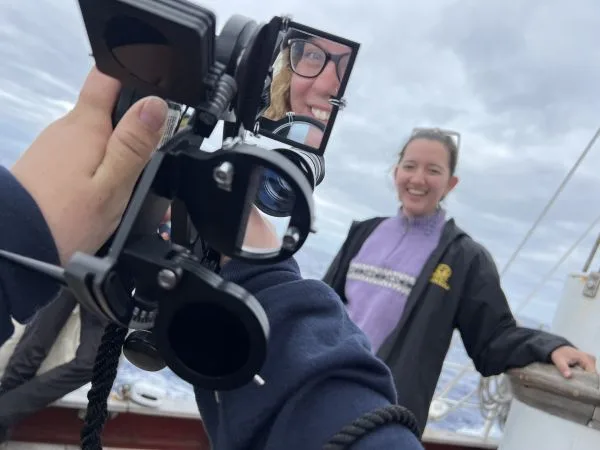Programs Blog
Bri’s Boat Life

Author: Brianna Padilla, A Watch, Hamilton College
Ship’s Log
Friday, April 12, 2024
Noon Position (Lat and Long): 39 50.3S x 155 08.5W
Ship Heading (degrees): 065
Ship Speed (knots): 6
Taffrail Log (nm): 1654
Weather / Wind / Sail Plan (from 1300 Watch Change): ENE wind, Beaufort Force 3. Motor sailing on a port tack under the stays’ls. Many squalls throughout the day with varying cloud cover.
Description of location: Southern South Pacific Gyre
We’ve been living on the Robert C. Seamans for 18 days now! The ship is 41m long and has 40 bunks. My bunk is located in Sleepy Hollow, which is in the aft (back) part of the boat. My bunk is right next to the heater, so I never get homesick because it always feels like Florida in my bunk! There are 6 neighborhoods on the boat. Sleepy Hollow, 16th Street and the Aft Cabin are all in the aft part of the boat, then the foc’sle, Shellback Alley and Gemini neighborhoods are in the forward part of the boat. There are bunk beds in all the neighborhoods and my bunk is the lower one. I have a shelf in my bunk, a drawer under it and a cubby next to it for all my stuff. I also have a photo wall in my bunk that I can look at when I miss my pets, friends and family.
Life on the boat is very different from life on land. We have a 3 day week where we go through 4 different watches: dawn, morning, afternoon and evening watch. If we’re on the deck team for watch we’ll rotate between lookout, helm (steering the boat), and navigation/weather logs. We do that rotation no matter what time watch is, and we also have watch specific tasks too. Morning watch is from 0700 to 1300 and we do Chores on this watch. During afternoon watch (1300 to 1900) we do a deck wash and evening watch (1900-0100) we do a galley deep clean. Dawn watch is from 0100 to 0700 and for that watch we just focus on staying awake. My favorite watch is afternoon watch because you can stay up a little later and play games. We always play bananagrams and card games after afternoon watch, which I really enjoy.
The lab team does different tasks during watch. We have a watch builder that tells us if we’re in lab or on deck for that watch. Morning watch does a Hydrocast and Neuston net deployment. Afternoon watch processes the water collected in the hydrocast by running pH and Chl-a tests. Afternoon watch also processes all the creatures we collect in the Neuston net by doing a 100-count. Evening watch does another Neuston net tow or a meter net tow (we rotate every night) and the 100-count analysis for that tow. Dawn watch does DNA extractions on what we’ve caught. My favorite lab activity is the 100-count. I love looking at the cool creatures we find in the ocean through the microscope. I always keep looking at the creatures, even after we reach 100. The first picture I took on the microscope camera was of a blue button jelly, which was in the first 100-count I did. I thought it was so beautiful and cool looking, so I attached the picture to the blog.
Happy Birthday Adrian! I know your birthday is the 13th, but time zones are weird, which is why I wrote this for the 12th hoping you’ll get it on the 13th. Shout out to all my family, friends and pets. Love and miss you all.
Brianna Padilla, A Watch, Hamilton College
https://sea.edu/wp-content/uploads/2024/04/4-12-24small.jpg
Recent Posts from the Ships
- Ocean Classroom 2024-A collaborative high school program with Proctor Academy
- Collaborations and Long-term Commitments: SEA’s Caribbean Reef Program Sets a Course for Coastal Programs that Compliment Shipboard Experiences.
- Sea Education Association students prepare for life underway using state of the art nautical simulation from Wartsila Corporation.
- SEA Writer 2022, Magazines From the Summer SEA Quest Students
- Technology@SEA: Upgrades Allow Insight into Ocean Depths
Programs
- Gap Year
- Ocean Exploration
- High School
- Science at SEA
- SEA Expedition
- SEAScape
- Pre-College
- Proctor Ocean Classroom
- Protecting the Phoenix Islands
- SPICE
- Stanford@SEA
- Undergraduate
- Climate and Society
- Climate Change and Coastal Resilience
- Coral Reef Conservation
- Marine Biodiversity and Conservation
- MBL
- Ocean Exploration: Plastics
- Ocean Policy: Marine Protected Areas
- Oceans and Climate
- Pacific Reef Expedition
- The Global Ocean: Hawai'i
- The Global Ocean: New Zealand